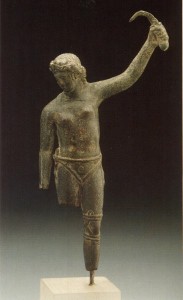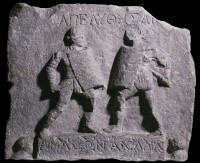 University of Granada researcher Alfonso Manas believes a bronze statue in the permanent collection of Germany’s Museum für Kunst und Gewerbein of Hamburg is an extremely rare depiction of a female gladiator, sword raised in victory while she looks down at an unseen defeated opponent. The statue is of a woman wearing nothing but a loincloth and a bandage around her left knee. In her left hand she raises aloft a sica, a short curved blade used by the thraex or Thracian type gladiator.
University of Granada researcher Alfonso Manas believes a bronze statue in the permanent collection of Germany’s Museum für Kunst und Gewerbein of Hamburg is an extremely rare depiction of a female gladiator, sword raised in victory while she looks down at an unseen defeated opponent. The statue is of a woman wearing nothing but a loincloth and a bandage around her left knee. In her left hand she raises aloft a sica, a short curved blade used by the thraex or Thracian type gladiator.
Thracians, however, also carried a small shield and wore armor — a helmet, greaves, an arm and shoulder piece called a manica, or sleeve — while this figure does not. The lack of armor suggests an athlete rather than a gladiator. The curved implement could be a strigil, a cleaning tool used to scrape oil and dirt off the body. Athletes were often depicted in the act of strigiling themselves, but the raised arm doesn’t fit with that tradition at all. The strigil stays connected to the body, or at least close to it, during the cleaning process. Holding a strigil aloft makes no sense. It’s much more in keeping with gladiatorial gestures of victory than with athletic hygiene.
In addition, female athletes in the Roman world did not go completely topless, as they would wear a bikini or “a tunic that left one breast exposed,” Manas pointed out. “In any case, female athletes never performed with bare breasts,” at least not with both exposed. Gladiators, on the other hand, tended to be slaves or people of low social status; depicting them topless would have been considered more acceptable. The bandage the woman is wearing on her knee is also a common feature of gladiators.
Altogether, this evidence “seems to indicate that the statuette at the MKG [the museum] represents a gladiator, thus becoming the second piece of visual evidence we have of female gladiators,” Manas writes in a recent issue of the International Journal of the History of Sport.
The other piece of visual evidence is a marble relief discovered in the ancient Greek city of Halicarnassus (modern Bodrum, Turkey) and now in the British Museum. The relief depicts two gladiatrices called Amazon and Achillia who have fought valiantly to a draw (stantes missio, meaning “dismissed while still standing”), a rare event requiring exceptional combat on both sides. Like the bronze, they are topless and wearing loincloths. Unlike the bronze, they wear traditional gladiatorial armature including greaves, a manica and a shield.
 It is possible that the statue was carrying a shield in her right arm which is broken just above the wrist. The lack of helmet could be explained by her victorious posture, since gladiators removed their helmets as gesture of victory. She might just have been stripped of gear to present a more erotic nude figure for decorative purposes. The relief of Amazon and Achillia took a more businesslike approach since it was probably affixed to the ludus, or gladiator training school.
It is possible that the statue was carrying a shield in her right arm which is broken just above the wrist. The lack of helmet could be explained by her victorious posture, since gladiators removed their helmets as gesture of victory. She might just have been stripped of gear to present a more erotic nude figure for decorative purposes. The relief of Amazon and Achillia took a more businesslike approach since it was probably affixed to the ludus, or gladiator training school.
If there were any sexual implication of the nude gladiator, it would’ve been due to her low social status. “In the Roman mind, there would have [been] certain associations with the sexual availability of slaves,” [Ohio State University professor Anna] McCullough said. “Slaves were sort of expected to be sexually available to anyone at anytime, especially their masters.”
To, “depict a female gladiator, or a slave, nude was really no big deal,” she said. “It was an indication of their extremely low status.”
I find it interesting how the BBC article about the relief mentions contemporary accounts of female gladiators but swiftly veers off into talking about high born ladies and male gladiators.
I noticed that. I guess the naughty society ladies slumming before Vesuvius rained down on them makes for good filler.
Scary … “Holding a strigil aloft makes no sense” … keep in mind that until recently things like cars were sold like that, i.e. topless. Back then, it would have been: Buy two strigils, get one for free.
However, she indeed looks more like a gladiatrix killer queen than a strigil vendor, cf.: http://en.wikipedia.org/wiki/Gladiatrix. There seems to be plenty of evidence, and apparently it became a fashion trend in the industry to let a female Achill fight against an, of course, real Amazon down in the circus pit. Similar to all these Gameshows of today.
:hattip:
I didn’t even think of the strigil vending possibilities! I imagine she would have gotten a lot of foot traffic. :giggle:
This is a remarkable statue. Maybe we need more info before we declare her a gladiator… maybe not. It’s a compelling theory.
I agree that there really is very little to go on. I wish we had some information about where the statue was discovered. That context could have been very helpful in sorting out what the statue depicts.
I don’t want to be blunter in case he had the right idea but expressed it awkwardly, but I was a bit discomfited by the opinion(s) on the statue’s (non-)eroticism.
Would it have been erotic (beyond any enjoyment of the sexual availability of the enslaved)?
It doesn’t seem like an erotic depiction to me, except in the general male-gaze sense of female nudes being presented as sexual objects. At the same time, the idea that there would have been no erotic element in the enjoyment of female gladiators seems highly unlikely to me. Just because contemporary sources don’t describe them in sexual terms doesn’t mean the audience wasn’t titillated. After all, male gladiators were most certainly fetishized.
Wut ? ‘Anchilia’ ? or as on the BM page ‘Achilia’ ? Well, it clearly says ‘Achillia’ on the marble, it reads:
a) απελυϑησαν = (“apelythesan”)
b) αχιλλια = (“Achillia”)
c) αμαζον(α) = (“Amazon(a)”)
Oh dear. That particular typo was brought on by a recent viewing of Tosca. You know how in the first act the sacristan sings the Angelus? “Ecce ancilla Domini” is a particularly prominent verse. It got stuck so far in my head that I added an ‘n’ to Achillia. :blush:
Thank you for the correction. I’ve fixed it in the entry. :thanks:
Yeah. It was just ‘In a society so militarised as the Roman one, in which weapons were so popular (but exclusive to men), to see a woman in that role, so different to the usual feminine one, wearing the armour of gladiators and showing so much of her anatomy, should also stimulate the imagination and the libido of spectators’… :confused: It sounded a little like he was rubbing his thighs as he wrote.
Why a gladiatrix and not an Amazon/female warrior, engaged in either battle or training? No armor, true, but this could be training, or your eroticization/fetishization of her as the killer woman, sexual warrior.
In a personal conversation and by e-mail the curator for the antiquities at the Museum für Kunst und Gewerbe informed me that the bended item in the hand of the statue already got bended in antiquity and used to be originally straight. Hence it cannot be a sica or strigilis. More likely it could have been a usual short sword or a sign of victory. The pose with the downward glance is in accordance with victory statues.
The determination of the sex is not so easy, the hairdo is very untypical and reminds of statues showing Apollo. You could think of a female with small breasts but according to Dr. Hildebrandt it is in accordance with late hellenistic sportsmen.